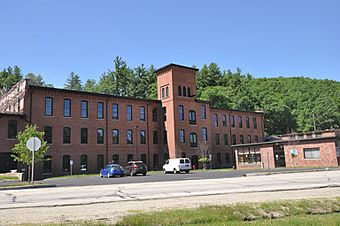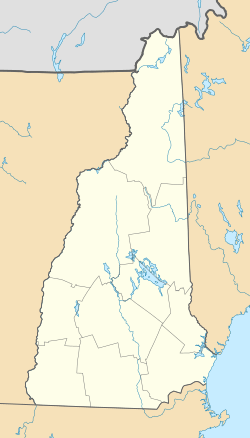Hillsborough Mills facts for kids
Quick facts for kids |
|
|
Hillsborough Mills
|
|
 |
|
| Location | 37 Wilton Road, Milford, New Hampshire |
|---|---|
| Area | 13.1 acres (5.3 ha) |
| Built | 1866 |
| NRHP reference No. | 13000383 |
| Added to NRHP | June 14, 2013 |
The Hillsborough Mills is a historic group of factory buildings in Milford, New Hampshire. It is located near the town line with Wilton. The oldest parts of this brick factory were built in 1866. At first, they were used to make carpets.
This carpet business didn't do well and closed in 1874. But other companies bought the buildings. They found success making carpet yarns and blankets for horses and beds. The mills finally closed in 1970. Since then, the buildings have been used for other purposes. The whole complex was listed on the National Register of Historic Places in 2014. This means it's an important historical site.
Contents
What is Hillsborough Mills Like?
The Hillsborough Mills sit on about 13 acres of land. It is next to Wilton Road and the Souhegan River. The main building is a long, three-story brick structure. It has a taller, four-story tower in the middle.
Building Features
The building looks like it's from the Italianate style. This means it has windows with rounded tops. It also has decorative brick patterns near the roof. The top floor of the tower has round-arch windows. Smaller brick additions were added to the building in the early 1900s.
How the Mill Got Power
Historically, the mill used water power. Water came through a canal from a dam in Wilton. The canal has since been filled in. Now, an underground pipe brings water to power a hydroelectric system. This system is in the mill's basement. The dam itself was rebuilt in 1986.
The Story of Hillsborough Mills
The main mill was built in 1866 by the Pine Valley Company. It started working that same year. A flood damaged its dam in 1869, but it was rebuilt. The company struggled with money and closed in 1874.
New Owners and Success
The Hillsborough Mills Company then bought the factory. This company made carpet wool and blankets. About 200 people worked there. They were successful until 1901. The mill closed because of tough competition from bigger factories.
A new group of investors bought the mill. One of them was William Abbott. Mr. Abbott ended up running three different factories in the area. He was very important to the local economy. He employed almost 500 workers. The Abbott family closed the mill in 1970. They sold the building in 1979. Today, it is used for many different light industrial businesses.



